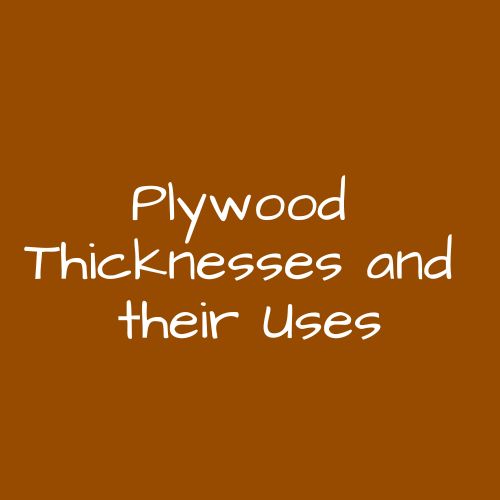Plywood Thicknesses and Their Uses: A Comprehensive Guide
Choosing the right plywood thickness is crucial, as it directly impacts the strength, stability, and suitability of the material for your specific application. In this comprehensive guide, we’ll explore the various plywood thicknesses and their uses, helping you make informed decisions for your next project.

Table of Contents
- Introduction
- Understanding Plywood Thicknesses
- Common Plywood Thicknesses
- 3.1. 1/8 inch Plywood
- 3.2. 1/4 inch Plywood
- 3.3. 1/2 inch Plywood
- 3.4. 3/4 inch Plywood
- Choosing the Right Plywood Thickness
- Long-Tail Queries Related to Plywood Thicknesses and Uses
- FAQs
- Conclusion
1. Introduction
Plywood is a composite material made by bonding together several layers of wood veneer. These layers, or plies, are arranged with their grain directions alternating, which provides plywood with strength, stability, and resistance to warping. The thickness of plywood can vary significantly, and selecting the right thickness is crucial to the success of your project.
2. Understanding Plywood Thicknesses
Plywood thickness is typically measured in inches or millimeters. The nominal thickness refers to the thickness before sanding, while the actual thickness may be slightly less due to sanding during manufacturing.
3. Common Plywood Thicknesses
3.1. 1/8 inch Plywood
- Uses: This extremely thin plywood is often used for backing in furniture, cabinet backs, and decorative panels.
- Pros: Lightweight and flexible, suitable for applications where minimal thickness is required.
- Cons: Lacks structural strength and durability.
3.2. 1/4 inch Plywood
- Uses: Commonly used for drawer bottoms, cabinet backs, and smaller projects. It can also be used for subflooring in some cases.
- Pros: Lightweight, reasonably strong for its thickness, and easy to work with.
- Cons: Not suitable for heavy-duty applications.
3.3. 1/2 inch Plywood
- Uses: Ideal for sheathing, subflooring, and interior wall and roof paneling. It’s often used in structural applications.
- Pros: Provides a good balance between strength and weight, making it versatile.
- Cons: May not be suitable for very heavy loads.
3.4. 3/4 inch Plywood
- Uses: This is a robust option suitable for heavy-duty applications like flooring, roofing, and larger furniture pieces.
- Pros: Offers significant strength and stability, making it ideal for structural purposes.
- Cons: Heavier and more expensive compared to thinner options.
4. Choosing the Right Plywood Thickness
Selecting the right plywood thickness depends on the specific requirements of your project. Consider the following factors:
- Application: Determine the intended use of the plywood – structural, decorative, or functional.
- Load-Bearing Capacity: If your project requires load-bearing capabilities, opt for thicker plywood.
- Budget: Thicker plywood tends to be more expensive, so choose based on your budget.
- Weight: Consider the weight limitations of your project, especially for applications that need to be lightweight.
5. Long-Tail Queries Related to Plywood Thicknesses and Uses
Here are some long-tail queries related to plywood thicknesses and their uses, along with brief answers:
- 1. What is the thinnest plywood available for projects?
- The thinnest plywood commonly used is 1/8 inch (3mm) plywood, suitable for backing and decorative purposes.
- 2. Can I use 1/2 inch plywood for a subfloor in a residential construction project?
- Yes, 1/2 inch plywood is often used for subflooring in residential construction, but it should be used with proper underlayment and support.
- 3. What’s the best plywood thickness for building shelves?
- The ideal thickness for shelves depends on the weight the shelves will bear. Typically, 3/4 inch plywood is a good choice for sturdy shelves.
- 4. Is 1/4 inch plywood strong enough for cabinet doors?
- 1/4 inch plywood is suitable for cabinet doors when backed with the appropriate framework, but it’s not as strong as thicker options.
- 5. Can I use 3/4 inch plywood for crafting small decorative items?
- While you can use 3/4 inch plywood for decorative items, it may be overkill for smaller projects. Thinner plywood options can be more cost-effective.
6. FAQs
6.1. What’s the difference between nominal and actual plywood thickness?
The nominal thickness refers to the thickness before sanding, while the actual thickness is the thickness after sanding during manufacturing.
6.2. Can plywood thickness affect the appearance of a project?
Yes, the thickness of plywood can influence the project’s appearance. Thicker plywood provides more substantial, robust lines, while thinner plywood may create a more delicate look.
6.3. Can I cut thicker plywood to the desired thickness for my project?
Yes, you can cut thicker plywood to the desired thickness using appropriate tools. However, this may not be as precise as purchasing the plywood at the desired thickness initially.
7. Conclusion
Selecting the right plywood thickness is a critical decision when starting a construction or woodworking project. The choice significantly impacts the project’s structural integrity, weight, and cost. By understanding the common plywood thicknesses and their typical uses, you can make informed decisions that ensure your project’s success. Remember to consider the specific requirements of your project, such as load-bearing capacity, budget, and aesthetics, when choosing the ideal plywood thickness for your needs.
Not Sure What Are You Looking At? Check the below guides:
Benefits of Using Reclaimed Wood
Benefits of Bamboo Wood
